Natural gas pipelines, hydrogen, drinking water or CO2 capture — you can’t do it without pumps, valves and compressors. At the same time, fluid systems have a reputation for being energy- and maintenance-intensive cost traps. Achema 2024 exhibition in Frankfurt, Germany, will once again be the world’s largest pump trade fair. Not only current developments, but also prospects for the future of turbomachines are given here.
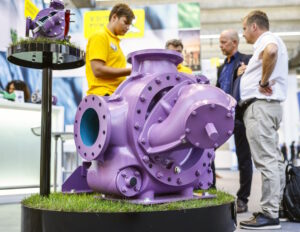
It is estimated that around a quarter of industrial electricity is used to pump fluids. In terms of global electricity production, this represents 10% of the world’s total — meaning that one in ten power stations is in operation just to provide the energy needed to move liquids from A to B. In particular, improperly dimensioned, worn or poorly controlled pumps, as well as inefficient compressors and compressed air leaks, are known to be huge energy wasters. In addition, pumps are often oversized due to ignorance or uncertainty. As a result, the units operate outside their optimum efficiency, have to be throttled and wear out more quickly. However, the consistent use of modern speed control systems could help to save 7.5 terawatt hours of energy and 4 million tonnes of CO2 emissions in Germany alone. Thanks to the lower energy consumption of controlled drives, improved impeller geometries or smaller clearances, the extra cost of new equipment is quickly amortised.
Another factor to consider is the enormous burden of high energy prices, particularly for companies with a high degree of upstream integration: Production processes such as the casting of machine parts or the testing of large pumps are expensive, with energy requirements in the megawatt range and huge costs for electricity and gas, experts warn — and point out that, unlike consumers, industrial companies do not benefit from fixed price guarantees. Energy and cost optimisation will therefore not only be part of the product development specifications for pump manufacturers in 2023, but also at the heart of their own manufacturing processes.
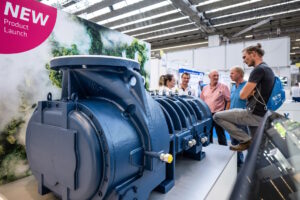
On the way to networked turbomachines – connectivity is required
The prevailing influence of energy efficiency is also reflected in the fact that the German Engineering Federation (VDMA), for example, sees the greatest potential for digital tools in this area. After all, a lot is happening in Fluidics 4.0: the asset administration shell finally brings the concept of the digital twin to life. Pumps, compressors, vacuum pumps and even connected fittings can now be specified in such a way that this information can be read and used by everyone involved in the process. OPC UA Companion Specifications are also available to ensure interoperability between components from different manufacturers.
Digital solutions also score when it comes to leak detection: Acoustic cameras combine ultrasonic sensors with optical imaging to detect leaks in pipelines or compressed air systems. With so-called gas cameras leaks cannot not only be detected, but the corresponding gas can also be identified. Today, such cameras are small enough to be available as handheld devices, but they can also be permanently installed.
A Danger Foreseen Is Half Avoided
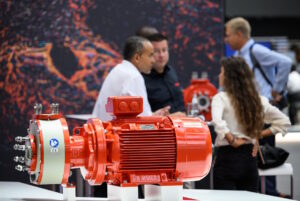
In addition to efficient drives and precise controls, more and more suppliers are using methods such as software-based anomaly detection, in which an algorithm examines current operating conditions. Based on these values, the software can make predictions about future malfunctions or anomalies and suggest appropriate measures. According to the VDMA, predictive maintenance can prevent around 70% of unplanned shutdowns. There are growing calls for the integration of condition monitoring — even for relatively simple components such as valves and even seals. This is not easy when the necessary sensor technology also has to work in the Atex area, for example. Even mechanical seals are making the leap into the digital world.
Operators are increasingly unwilling to take risks, especially when dealing with explosive or environmentally hazardous substances. Sealless magnetically coupled pumps are therefore in great demand.
New Media for the Energy Transition
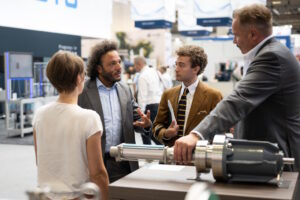
Of course, pumps & systems will also be needed in the energy and raw materials value chains of the future: hydrogen, for example, as the smallest molecule in the periodic table, places special demands on pumps and compressors. The gas is highly volatile and can penetrate the crystal lattice of metallic materials, leading to hydrogen embrittlement.
It is therefore important to take a close look at the components used — from the pump to the fittings. After all, requirements such as specific materials and surface qualities are often not specified. For this reason, pump manufacturers are currently drawing on their expertise from “classic” hydrogen projects in the chemical industry, even though not every detail has yet been clarified. For example, developers complain that there are still unresolved questions about hydraulic balancing or the operation of pumps in different hydrogen processes.
This also applies to the size of future hydrogen projects: While typical modular container plants currently produce around 10 m³/h, large world-scale plants can produce 800 m³/h — as can the operating pressure, which can range from 6 to 40 bar.
Also on the pumping experts’ agenda are processes for CO2 capture and utilisation or storage. For these processes, pumps must cover a wide range of applications, be ready for use in a short time and be able to withstand very high pressures and temperatures, the manufacturers explain. Then there are the challenges of CO2 as a medium, such as its volatility — carbon dioxide exists as a gas phase at ambient pressure — which requires a suitable seal.
Exploiting Energy and Efficiency Potential
Liquefied natural gas is expected to satisfy Europe’s hunger for energy and compensate for the loss of supplies from Russia. At $27 billion worldwide, more than ten times as much money will be invested in gas projects and terminals in 2022 as in 2020. This also includes the corresponding fluidics, especially since the extreme conditions of the cryogenic medium require high-performance components.
For example, gas terminals and refuelling stations are just as dependent on cryogenic pumps and valves as ship refuelling. The components must be able to withstand temperatures below -160 °C and safely contain the explosive vapours produced during evaporation. Single or multi-stage centrifugal pumps are used for this purpose, but the extreme conditions make seal-less designs such as canned motor pumps more suitable.
For good reason, explosion protection and Atex certification place high demands on the components used. LNG regasification in particular requires suitable safety valves due to the extreme pressures involved.
The EU’s planned ban on so-called persistent chemicals or PFAs (perfluorinated and polyfluorinated chemicals) covers FKM and other fluorinated elastomeric plastics such as PTFE, FFKM, FEPM, PFA or FEP. These materials are also PFAS by definition and are therefore likely to be banned from 2026.
As a result, some of the most important materials for seals could disappear from the market. If this ban goes ahead as planned, the consequences would be dramatic: there are currently no alternative materials that could replace PFAS seals. The impact on industry and society would be significant: it is estimated that around 80% of industrial production would be affected. Not only that, but water and energy supplies, as well as the health sector, would also suffer massive problems. As a result, insiders expect the law to be watered down, if at all. However, it is virtually impossible that ECHA will back down completely. Regardless of how the PFAS issue develops, the fluid handling industry cannot ignore it.
The only option for manufacturers is to take the bull by the horns: suppliers want to become less dependent on the chemical industry by offering a diversified range of products. But this will also require innovation and ideas that go beyond fluidics, which is already highly developed. This includes digital services as well as customised solutions to meet market and regulatory requirements close to the customer.
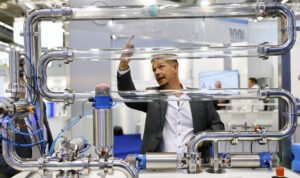
About Achema
Achema is the world forum for chemical engineering, process engineering and biotechnology. The world’s leading show for the process industry takes place every three years in Frankfurt. The spectrum ranges from laboratory equipment, pumps and analytical devices to packaging machinery, boilers and stirrers to safety technology, materials and software, thus covering all the needs of the chemical, pharmaceutical and food production industries. The accompanying congress, featuring scientific lectures and numerous guest and partner events, complements the wide range of exhibition themes. The next ACHEMA will take place from 10 to 14 June 2024 in Frankfurt am Main.












